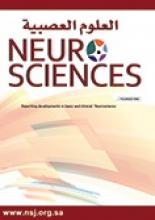Research ArticleOriginal Article
Open Access
The interrelated effects of 2D angiographic morphological variables and aneurysm rupture
Tianlun Qiu, Guoliang Jin and Wuqiao Bao
Neurosciences Journal July 2014, 19 (3) 210-217;
Tianlun Qiu
From the Department of Neurosurgery, Shaoxing City People’s Hospital, Shaoxing, Zhejiang, China
MSGuoliang Jin
From the Department of Neurosurgery, Shaoxing City People’s Hospital, Shaoxing, Zhejiang, China
BSWuqiao Bao
From the Department of Neurosurgery, Shaoxing City People’s Hospital, Shaoxing, Zhejiang, China
MS
References
- ↵
- UCAS Japan Investigators,
- Morita A,
- Kirino T,
- Hashi K,
- Aoki N,
- Fukuhara S,
- et al.
- ↵
- A.D.A.M. Inc. Medical Encyclopedia
- ↵(1998) Unruptured intracranial aneurysms--risk of rupture and risks of surgical intervention. International Study of Unruptured Intracranial Aneurysms Investigators. N Engl J Med 339, 1725–1733.
- ↵
- Wiebers DO,
- Whisnant JP,
- Huston J 3rd.,
- Meissner I,
- Brown RD Jr.,
- Piepgras DG,
- et al.
- ↵
- Broderick JP,
- Brott TG,
- Duldner JE,
- Tomsick T,
- Leach A
- Fogelholm R,
- Hernesniemi J,
- Vapalahti M
- ↵
- Horowitz M
- Komotar RJ,
- Mocco J,
- Solomon RA
- ↵
- Lee T,
- Baytion M,
- Sciacca R,
- Mohr JP,
- Pile-Spellman J
- ↵
- Ujiie H,
- Tamano Y,
- Sasaki K,
- Hori T
- ↵
- Hoh BL,
- Sistrom CL,
- Firment CS,
- Fautheree GL,
- Velat GJ,
- Whiting JH,
- et al.
- ↵
- Baharoglu MI,
- Schirmer CM,
- Hoit DA,
- Gao BL,
- Malek AM
- ↵
- Cebral JR,
- Castro MA,
- Burgess JE,
- Pergolizzi RS,
- Sheridan MJ,
- Putman CM
- ↵
- Lall RR,
- Eddleman CS,
- Bendok BR,
- Batjer HH
- ↵
- Cebral JR,
- Sheridan M,
- Putman CM
- ↵
- Lauric A,
- Baharoglu MI,
- Malek AM
- ↵
- Wiebers DO,
- Whisnant JP,
- O’Fallon WM
- ↵
- Baharoglu MI,
- Lauric A,
- Gao BL,
- Malek AM
- ↵
- Sato K,
- Imai Y,
- Ishikawa T,
- Matsuki N,
- Yamaguchi T
- ↵
- Rahman M,
- Smietana J,
- Hauck E,
- Hoh B,
- Hopkins N,
- Siddiqui A,
- et al.
- ↵
- Rengier F,
- Weber TF,
- Giesel FL,
- Bockler D,
- Kauczor HU,
- von Tengg-Kobligk H
- ↵
- Diehm N,
- Herrmann P,
- Dinkel HP
- ↵
- Amenta PS,
- Yadla S,
- Campbell PG,
- Maltenfort MG,
- Dey S,
- Ghosh S,
- et al.
- ↵
- Ryu CW,
- Kwon OK,
- Koh JS,
- Kim EJ
- ↵
- Carter BS,
- Sheth S,
- Chang E,
- Sethl M,
- Ogilvy CS
In this issue
The interrelated effects of 2D angiographic morphological variables and aneurysm rupture
Tianlun Qiu, Guoliang Jin, Wuqiao Bao
Neurosciences Journal Jul 2014, 19 (3) 210-217;
Jump to section
Related Articles
- No related articles found.
Cited By...
- No citing articles found.





